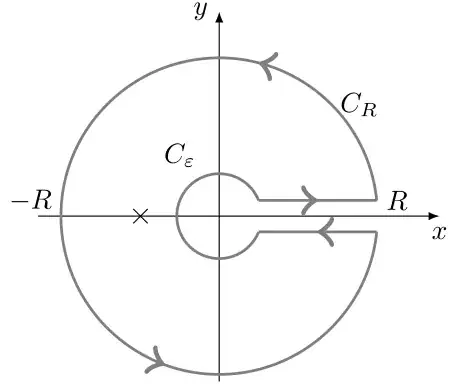The first thing is that I will evaluate the more general integral
\begin{align*}
I_{a,n} = \int_0^{\infty} \frac{x^{a-1}}{1+x^n} \mathrm{d}x
= \frac{1}{n} \int_0^\infty \frac{u^{a/n-1}}{1+u}\mathrm{d}u
\end{align*}
with $u \mapsto x^n$. I actually evaluated the last integral in my soon to be published master thesis about Hankel forms and Dirichlet series.
The last integral is the same as the Mellin transform of $f(x) = 1/(1+x)$ that is
\begin{align*}
\mathcal{M}_f(s) = \int_0^{\infty} x^{s-1} f(x) \mathrm{d}x = \frac{\pi}{\sin \pi s}
\end{align*}
We will compute this Mellin transform using complex analysis, and then you can use the first line to obtain the value of your integral. Consider the branch of $z^{s-1}/(z+1)$ defined on the slit plane $C\backslash[0,\infty)$ by
\begin{align*}
f(z) = \frac{r^{s-1}e^{i(s-1)\theta} }{z+1}\,,
\end{align*}
where $z = re^{i\theta}$, and $\theta \in (0,2\pi)$. For small $\varepsilon$ and $R > 1$, we consider the keyhole domain $C$,

consisting of $z$ in the slit plane $\mathbb{C}\backslash[0,\infty)$ satisfying $\varepsilon < |z| < R$, see the figure above. Since $f$ has a simple pole at $ =-1$, Cauchy's residue theorem yields
\begin{align}
\int_C f(z) = 2\pi i \operatorname{Res}\limits_{z = -1}f(z) = -2\pi i e^{\pi i s}\,. \tag{0}
\end{align}
The integral over $C$ breaks into the sum of $4$ integrals.
\begin{align}
\begin{split}
\int_{C} f(z) \mathrm{d}z
& = \int_{\varepsilon}^R \frac{x^{s-1}}{x+1} \mathrm{d}x
+ \int_{C_R} \frac{z^{s-1}}{z+1} \mathrm{d}z \\
& + \int_R^{\varepsilon} \frac{e^{2\pi i(s-1)}x^{s-1}}{1+x} \mathrm{d}x
+ \int_{C_\varepsilon} \frac{z^{s-1}}{z+1} \mathrm{d}z \,,
\end{split}
\tag{1}
\end{align}
and for the integrals over $C_R$ and $C_\varepsilon$ we obtain the following estimates
\begin{align}
\left|
\int_{C_R} \frac{z^{s-1}}{z+1} \mathrm{d}z
\right|
& \leq \frac{R^{s-1}}{R-1} 2\pi R = O(R^{s}) \,, \tag{2} \\
\left|
\int_{C_\varepsilon} \frac{z^{s-1}}{z+1} \mathrm{d}z\,.
\right|
& \leq \frac{\varepsilon^{s-1}}{1 - \varepsilon} 2\pi \varepsilon = O(\varepsilon^s) \tag{3}
\end{align}
Letting $R \to \infty$ and $\varepsilon \to 0$ we see that ($2$) and ($3$) vanishes. That is since it is assumed that $0 < s < 1$ in order to assure that the Mellin transform converges. Thus for $\varepsilon \to 0$ and $R \to \infty$ equation ($1$) becomes
\begin{align*}
\Bigl( 1 - e^{2\pi i(s-1)}\Bigr)\int_0^{\infty} \frac{x^{s-1}}{x+1} \mathrm{d}x
= -2\pi i e^{\pi i s}\,,
\end{align*}
where equation ($0$) was also applied. Thus,
\begin{align*}
\mathcal{M}_g(s)
= \int_0^{\infty} \frac{x^{s-1}}{1+x} \mathrm{d}x
= \pi \frac{2i}{e^{\pi i s-2\pi i} - e^{-\pi i s}}
= \frac{\pi}{\sin(\pi s)}\,,
\end{align*}
and we are done.
